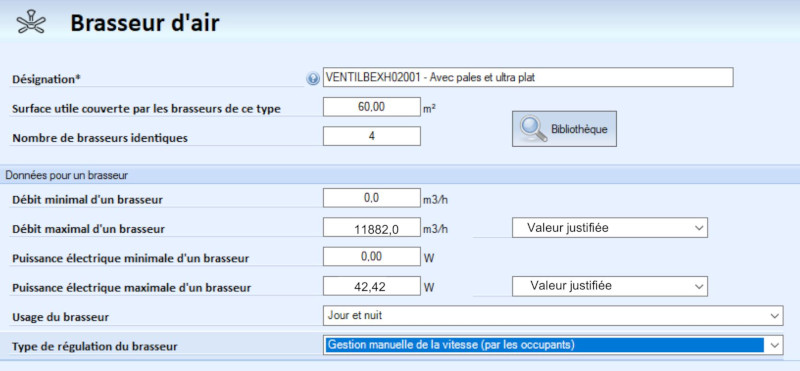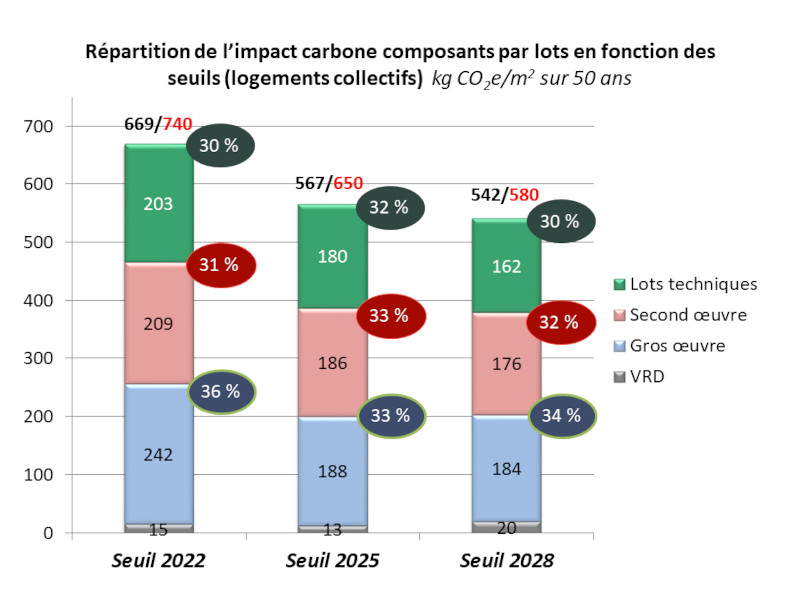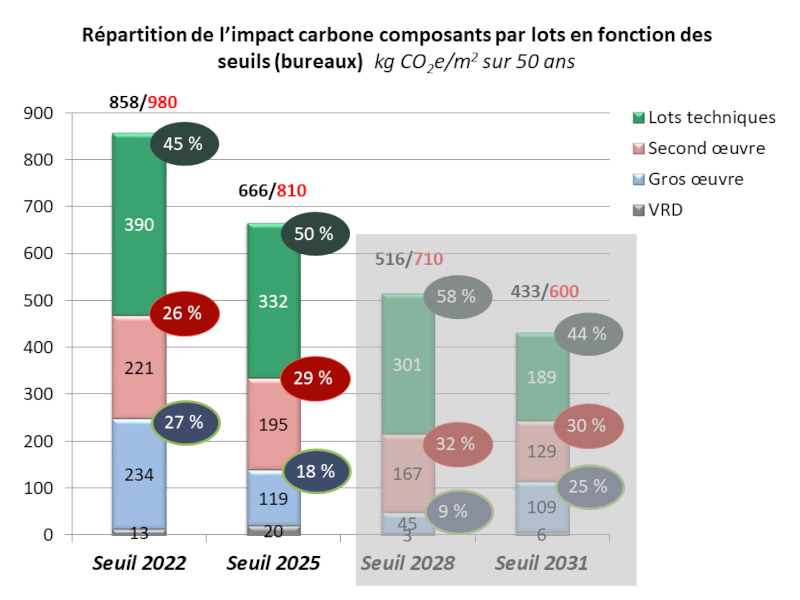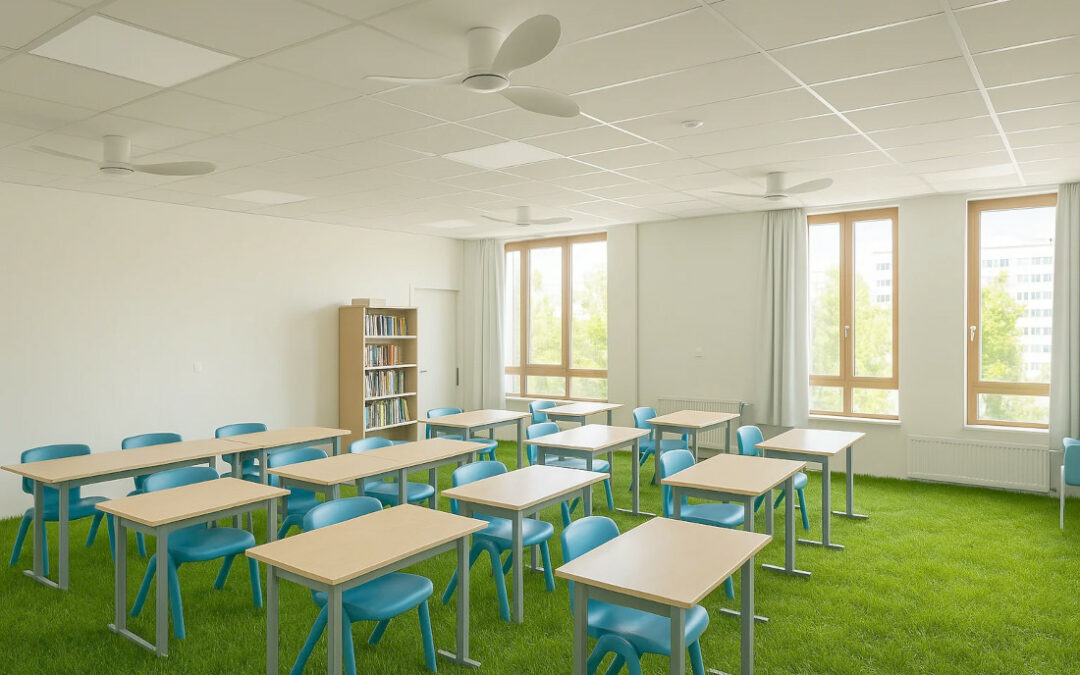In May 2025, the planet’s CO2 watchdog, the Mauna Loa volcano observatory in Hawaii[i], delivered its verdict: carbon dioxide levels had reached 428 particles per million (ppm). This value does not correspond to an exceptional episode, but rather to a steady increase, given that the first measurements date back to 1958.

Figure 1: Changes in CO2 concentrations from 1958 to 2025
For its part, the IPCC’s recent AR6 report shows in its SSP8.5 scenario[ii] that the concentration of CO2 in the atmosphere could rise to 1135 ppm by 2100..

Figure 2 : évolution des concentrations de CO2 dans l’atmosphère à horizon 2100 (source GIEC[iii])
Carbon’s impact on global warming is the one most often highlighted. But here we would like to highlight another aspect of carbon dioxide. For many years now, we have known that indoor air quality plays a significant role in our cognitive performance[iv]. According to a study published by New York University[v], a level of just 1,000 ppm of CO₂ is enough to reduce our decision-making faculties by 11% to 23%. However, if we reach 1,135 ppm by 2100, the air outside will be of the same quality as the air we consider unhealthy indoors today! So it’s no longer a question of complying with environmental rules for the sake of compliance. Being vigilant about greenhouse gas emissions is far from trivial. This is where the carbon component of the RE2020 can play a role. From 1 January 2025, more ambitious thresholds will apply to new buildings, taking a long-term perspective. Let’s take a look at the concrete benefits of the RE2020 carbon requirements, and how the deployment of ceiling fans (BAP) can help to make our buildings more energy-efficient.
RE2020 and carbon: the ramp-up
When it comes out in 2022, the RE2020 has deliberately limited its carbon ambitions to focus on energy issues.
However, the guidelines were set out, and 3 deadlines were defined for the carbon thresholds: 2025, 2028 and 2031.
They apply to two concepts[vi]:
- The Construction Carbon Indicator (IC Construction) measures emissions from materials and processes used in construction,
- The energy carbon indicator (IC Energie) concerns the carbon impact of the building’s energy consumption in the operational phase.
In the case of teaching, these thresholds decrease significantly over time.
| Indicator | Year | Primary or secondary school | Threshold (kg CO₂/m²) | Reduction / 2022 (%) |
|---|---|---|---|---|
| IC Construction | 2022 | Primary or secondary school | 900 | – |
| 2025 | 770 | -14% | ||
| 2028 | 680 | -24% | ||
| 2031 | 590 | -34% | ||
| IC Energie | 2022 | Primary or secondary education with district heating network | 240 | – |
| 2025 | 200 | -17% | ||
| 2028 | 140 | -42% | ||
| 2022 | Primary or secondary education – other cases | 240 | – | |
| 2025 | 140 | -42% | ||
| 2028 | 140 | -42% |
Figure 3: Changes in carbon thresholds for education
For offices, the configuration is different: the thresholds of the Construction CI are being significantly lowered, but the requirements of the Energy CI are not changing, except in 2025 for offices with a district heating network (RCU).
| Indicator | Year | Office category | Threshold (kg CO₂/m²) | Reduction / 2022 (%) |
|---|---|---|---|---|
| IC Construction | 2022 | Offices | 980 | – |
| 2025 | Offices | 810 | -17% | |
| 2028 | Offices | 710 | -28% | |
| 2031 | Offices | 600 | -39% | |
| IC Energie | 2022 | Offices with DHN* | 280 | – |
| 2025 | Offices with DHN* | 200 | -29% | |
| 2028 | Offices with DHN* | 200 | -29% | |
| 2022 | Offices – other cases | 200 | – | |
| 2025 | Offices – other cases | 200 | 0% | |
| 2028 | Offices – other cases | 200 | 0% |
Finally, for collective housing, the carbon challenge for construction is slightly less ambitious than for the tertiary sector, but the effort required in terms of energy consumption is very ambitious.
| Indicator | Year | Category | Threshold (kg CO₂e/m²) | Reduction / 2022 (%) |
|---|---|---|---|---|
| IC Construction | 2022 | Multi-unit residential buildings | 740 | – |
| 2025 | Multi-unit residential buildings | 650 | -12% | |
| 2028 | Multi-unit residential buildings | 580 | -22% | |
| 2031 | Multi-unit residential buildings | 490 | -34% | |
| IC Energie | 2022 | Multi-unit residential buildings with DHN* | 560 | – |
| 2025 | Multi-unit residential buildings with DHN* | 320 | -43% | |
| 2028 | Multi-unit residential buildings with DHN* | 260 | -54% | |
| 2022 | Multi-unit residential buildings – other cases | 560 | – | |
| 2025 | Multi-unit residential buildings – other cases | 260 | -54% | |
| 2028 | Multi-unit residential buildings – other cases | 260 | -54% |
Figure 5: Evolution of carbon thresholds for multi-unit residential buildings (DHN = District Heating Network), source: Legifrance[vii]
To sum up, these objectives aim to :
- For materials (IC construction), to follow the reduction target of the National Low-Carbon Strategy (SNBC), which aims to be carbon neutral by 2050,
- For energy (IC energy), to put an end to the use of fossil fuels in buildings by 2025.
IC Construction: the design challenge
When designing a new project, the choice of low-carbon solutions, such as ceiling fans, seems appropriate for several reasons:
- meet the RE2020 regulatory targets,
- involvement of the builder and the client in the climate objectives,
- in some cases, eligibility for recognised labels such as HQE, Bâtiments Durables[viii], BREEAM, LEED, etc., which promote high-quality properties in environmental terms,
- economic optimisation, as the solutions offering the best carbon/price ratio are always sought by the operators concerned.[ix]
As part of this focus on construction, it should be noted that Samarat has just been awarded two PEP (Product Environmental Profile) certificates.
Ecopassport® PEPs concern electrical, electronic and HVAC equipment products. They are the environmental identity cards for products, based on the results of their Life Cycle Assessment.
Using the same calculation basis, the Samarat appears to be 80% more carbon-efficient than the DED (Déclaration Environnementale par Défaut) sheet for ceiling fans drawn up by the French Ministry of Ecology.
All the details on these sheets are available in the pro area, by following this process :
- First log in to your pro area
- Then click on this link once you are logged in
IC Energie: reducing the carbon impact of operations
Calculation of the Energy CI
This indicator concerns the carbon impact of the building’s energy consumption during the operational phase.
It is calculated not on the basis of data from a PEP sheet or an Environmental Defect Statement, but on the basis of the ceiling fan’s energy consumption during the summer season.
This is estimated in a conventional way, based on the input parameters for the energy section of the RE2020.

The RE2020 calculation engine first determines annual consumption in kWh.
It then converts it into kg CO2e according to the regulatory carbon mix below.
| Type of energy per kWh (final energy, LHV basis) | kg CO₂ equivalent per kilowatt-hour of final energy (LHV) |
|---|---|
| Electricity – Non-residential lighting | 0,064 |
| Electricity – Cooling | |
| Electricity – Other uses | |
| Electricity – Domestic hot water (DHW) | 0,065 |
| Electricity – Residential lighting | 0,069 |
| Electricity – Heating | 0,079 |
For the IC Energy section, ceiling fans are assigned a coefficient of 0.064 kg CO2e/kWhef. Note that the conversion is based on final energy.
The most efficient ceiling fans according to this IC Energy indicator are therefore those that achieve the degree-hour targets while minimising energy consumption.
In practice, good energy efficiency in m3/Wh helps to achieve this, as the aim is to obtain the best ratio between maximum airflow (m3/h) and maximum power (W).
For the Samarat, the energy efficiency is (11,882 m3/h) / (42.42 W), i.e. 280 m3/h.
Good energy efficiency reduces annual consumption and improves the IC Energy indicator.
It should also be remembered that flow and power levels can have three theoretical statuses: ‘declared value’, ‘justified value’ or ‘certified value’.
To our knowledge, there are no certification standards for air blowers. On the other hand, some appliances have values substantiated by tests in approved laboratories. These justified values enable them to benefit from a favourable corrective coefficient in the RE2020 calculation engine. This is the case for the Samarat.
Limits of the RE2020 on the Energy CI
It’s not unusual to see ceiling fans and air conditioning as opposites. However, according to a study carried out by the University of Berkeley[x], the benefits of hybrid cooling (combining air conditioning and ceiling fans) can reduce energy consumption by 32%, without compromising thermal comfort.
In practice, particularly in existing buildings, this naturally translates into a proportional carbon impact. Unfortunately, the RE2020 calculation engine does not yet allow this to be taken into account. In fact, this was one of the points for improvement in the RE2020 that we raised in our May 2025 article entitled: « Ceiling fans and the RE2020: holes in the racket?». Nevertheless, it is still possible to simulate summer energy gains using dynamic energy simulation, as we explained in our publication dedicated to DTS.
Since the DTS calculation compares the savings made on air conditioning (after deducting consumption specific to ceiling fans), the carbon calculation can be adjusted in the use phase, even if this has no regulatory consequences. In premises where this is possible, heating gains in winter should also be taken into account if the fans are used at low speed in destratification mode. Here again, the savings can be considerable: 3% energy savings per metre of ceiling height, according to a 2007 Australian study[xi]. As with hybrid cooling, the heating savings associated with destratification are not included in the RE2020 calculation.
Making the right choices in building
The visual below, taken from the work of the IFBEP/Carbone 4 low-carbon specifiers’ hub, represents a sample of the hub’s real projects[xii]. It provides a concrete understanding of the carbon challenge for the various lots. At the top of each histogram is the cumulative value for the different lots in black, and the corresponding IC Construction threshold in red. It can be seen that in Multi-unit residential buildings as a whole, the shell, finishings and technical packages each account for almost a third of the carbon impact.

Figure 8: Weight of the various Multi-unit residential buildings in terms of carbon impact [xiii](source IFPEB/Carbone 4)
The situation for offices[xiv] is quite different. The impact of technical packages is predominant, very close to 50%. Finishing work accounts for around 30%.
In the diagram below, the values for 2028 and 2031 are shaded in grey, as they are limited to a single project, and are therefore less representative.

Figure 9: Carbon impact of different office blocks (source IFPEB/Carbone 4)
The reasoning per m² is extremely relevant[xv]. In fact, if we consider ceiling fans, we can make a general assumption of one unit per 15 m² of surface area, in accordance with the RE2020 rules.
SIf we take the Ministry’s Default Environmental Declaration (DED) as a reference for ceiling fans, it gives a ‘carbon weight’ of 383 kg CO2e over 50 years (in RE2020 LCA). On a per m² basis, this represents 383/15, or 26 kg CO2e/m² [xvi].
As can be seen in the table below, for Multi-unit residential buildings, fans, which represent 13% of the overall weight of technical packages in 2022, rise to 16% with the 2028 threshold.
For offices, if we take the average assumption for the hub of the technical packages, the impact is slightly less (because the weight of the technical packages is greater): for the ceiling fan, we go from 7% to 14% of the overall weight of the technical packages between the 2022 and 2031 thresholds.
| Carbon impact of technical building systems (kg CO₂e/m²) — based on projects from the Low-Carbon Specifiers Hub | 2022 threshold | 2025 threshold | 2028 threshold | 2031 threshold |
|---|---|---|---|---|
| Multi-unit residential buildings | 203 | 180 | 162 | Non communiqué |
| Offices | 390 | 332 | 301 | 189 |
| Ratio: Ceiling fan (26 kg CO₂e/m²) vs. total technical systems | 2022 threshold | 2025 threshold | 2028 threshold | 2031 threshold |
| Multi-unit residential buildings | 13% | 14% | 16% | N.S. |
| Offices | 7% | 8% | 9% | 14% |
Figure 10: Evolution of the carbon weight of technical packages and the relative share of ceiling fans based on the DED (IFPEB/Carbone 4 data)
Carbon savings will therefore have to be sought everywhere if the new thresholds are to be met, which is why ceiling fans that are more carbon-efficient than the DED are becoming a major asset.
In this respect, Samarat’s PEP sheets radically change the situation in terms of carbon impact (see our link above in the chapter devoted to IC Construction).
What value can be placed on kg of carbon?
It’s a very tricky business. Nevertheless, we can estimate things on the basis of Multi-unit residential buildings.

Let’s assume a cost price in 2024 estimated at €2,500 excluding VAT/m² (corresponding to the threshold of 740 kgCO2e/m²). It is common practice to estimate the additional cost associated with carbon requirements at 10% by 2031 (threshold 490 kg CO2e/m²), excluding inflation. To summarise:
- Additional carbon cost per m² = 10% of €2,500, i.e. €250.
- Change in requirements per m² = 740-490 = 250 kg CO2e
On this basis, the cost per kg of CO2 is precisely €1, or €1,000 per tonne. For the record, this is a long way from the carbon market price (€64 per tonne in April 2025[xvii]), bearing in mind that France Stratégie[xvii] puts the value of a tonne of CO2 avoided at €256. The RE2020 therefore puts a much higher value on carbon than the other mechanisms available today: four times more than the value per tonne estimated by France Stratégie and fifteen times more than the current market. The stakes for new buildings are therefore considerable.
Ceiling fans: a potential source for reducing CO2 in buildings
With ceiling fans, designers have a major tool at their disposal for improving carbon impact, both during the building production phase (IC Construction) and during the operating phase (IC Energy).
To this must be added other benefits not taken into account by the RE2020: winter gains, mid-season gains (staggered start-up and shut-down of air conditioning) and some of the summer gains associated with these devices, such as coupling with air conditioning.
Today, the fact that we have extremely carbon-efficient PEP sheets is a major advantage, enabling us to make the trade-offs that are essential for the production of energy-efficient and environmentally-friendly buildings.
We would like to thank Guillaume Meunier, Low Carbon Consultant at the IFPEB, who kindly reviewed this article.
[i] The series can be viewed here: https://gml.noaa.gov/ccgg/trends/
[ii] This scenario is considered the most likely for 2050 by Carbone 4’s group of consultants, see here : https://www.carbone4.com/publication-scenarios-ssp-adaptation
[iii] Source: IPCC AR6 report: https://www.ipcc.ch/report/ar6/wg1/downloads/report/IPCC_AR6_WGI_FAQ_French.pdf
[iv] For our health to really begin to suffer, we would need to reach 20,000 ppm. So we’re a long way from that. On the other hand, our cognitive abilities deteriorate at much lower levels.
[v] Source : https://pmc.ncbi.nlm.nih.gov/articles/PMC3548274/
[vi] There are six carbon indicators. Three impose thresholds to be respected (Ic energy, Ic construction and Ic total) and three others are indicative. The informative indicators are as follows: Ic non-renewable energy (specifies the proportion of GHG emissions linked solely to non-renewable energy sources), IC construction PCE (GHG emissions linked solely to construction products and equipment, without transport or worksite) and Ic worksite (GHG emissions linked to the worksite phases, including transport, machinery, etc.). It should be noted that a lump sum related to the worksite is included in the construction CI, whereas the worksite CI gives a detailed value for educational purposes.
[vii] For the energy CI and the construction CI, we have taken as a basis decree no. 2024-1258 of 30 December 2024 modifying the energy and environmental performance requirements for building constructions in mainland France. https://www.legifrance.gouv.fr/jorf/id/JORFTEXT000050873122 and the appendix to the CCH : https://www.legifrance.gouv.fr/codes/article_lc/LEGIARTI000045292850
[viii] We are thinking here of regional labels awarded by associations recognised under the Collectif des Démarches Bâtiments Durables (Sustainable Building Initiative Collective) : Bâtiments Durables Méditerranéens (EnvirobatBDM, PACA), Bâtiments Durables Occitans (Envirobat Occitanie), Bâtiments Durables Franciliens (Ekopolis, IDF), BDNA (Odéys, Nouvelle-Aquitaine), BDBFC (Terragilis, Bourgogne-Franche-Comté), BDB (Batylab, Bretagne)…
[ix] Low-carbon solutions can also be a source of savings, as the webinar “RE2028 : « free (or almost free) levers» the Low Carbon Prescribers Hub.
[x] Accessible in connected mode. Always remember to log in to your account before clicking on the link.
[xi] Circulating fans for summer and winter comfort and indoor energy efficiency, Richard Aynsley, see here on pro area (Study showing energy savings of 7 to 10% per degree of air-conditioning set point), available on simple registration.
[xii] The full presentation can be downloaded here: https://www.ifpeb.fr/re2020-reussir-les-seuils-futurs/
[xiii] The facades are included in the finishing work package.
[xiv] The presentation for the offices is on line on the IFPEB website : https://www.ifpeb.fr/accelerer-la-reussite-de-la-re2020-pour-les-bureaux/
[xv] We strongly suggest that designers read the work of this hub, which is available at this address : https://www.ifpeb.fr/travaux/le-hub-des-prescripteurs-bas-carbone/
[xvi] This value may seem high; to be more accurate in the evaluations, it is recommended to rely on the good practices of dimensioning and layout mentioned in our linked article : https://www.brasseurs-air-re2020.com/brasseurs-dair-quelles-regles-de-calepinage/ A very interesting point to note: to take account of the issue of summer comfort, a geographical modulation is planned in the RE2020, up to +30 kg CO2e/m² for zones H2d and H3 and <400m altitude.
[xvii] Day-to-day carbon market prices : https://fr.investing.com/commodities/carbon-emissions
[xviii] See the report ‘The value of climate action: a benchmark for assessment and action’. https://www.strategie.gouv.fr/publications/la-valeur-de-laction-pour-le-climat-une-reference-pour-evaluer-et-agir


